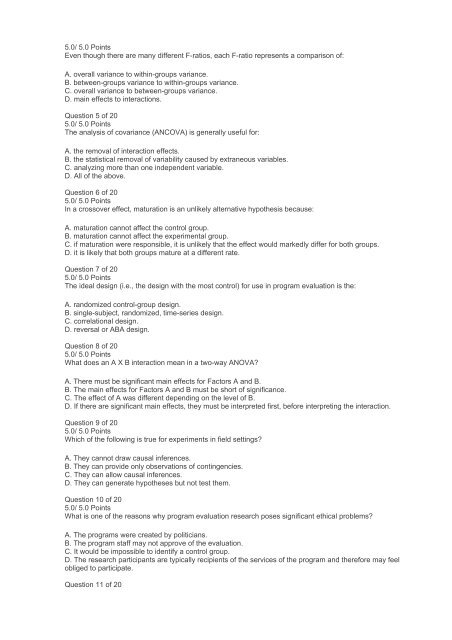PS370 Research Methods in Psychology Online Exam 8 Answers (Ashworth College)
Create successful ePaper yourself
Turn your PDF publications into a flip-book with our unique Google optimized e-Paper software.
5.0/ 5.0 Po<strong>in</strong>ts<br />
Even though there are many different F-ratios, each F-ratio represents a comparison of:<br />
A. overall variance to with<strong>in</strong>-groups variance.<br />
B. between-groups variance to with<strong>in</strong>-groups variance.<br />
C. overall variance to between-groups variance.<br />
D. ma<strong>in</strong> effects to <strong>in</strong>teractions.<br />
Question 5 of 20<br />
5.0/ 5.0 Po<strong>in</strong>ts<br />
The analysis of covariance (ANCOVA) is generally useful for:<br />
A. the removal of <strong>in</strong>teraction effects.<br />
B. the statistical removal of variability caused by extraneous variables.<br />
C. analyz<strong>in</strong>g more than one <strong>in</strong>dependent variable.<br />
D. All of the above.<br />
Question 6 of 20<br />
5.0/ 5.0 Po<strong>in</strong>ts<br />
In a crossover effect, maturation is an unlikely alternative hypothesis because:<br />
A. maturation cannot affect the control group.<br />
B. maturation cannot affect the experimental group.<br />
C. if maturation were responsible, it is unlikely that the effect would markedly differ for both groups.<br />
D. it is likely that both groups mature at a different rate.<br />
Question 7 of 20<br />
5.0/ 5.0 Po<strong>in</strong>ts<br />
The ideal design (i.e., the design with the most control) for use <strong>in</strong> program evaluation is the:<br />
A. randomized control-group design.<br />
B. s<strong>in</strong>gle-subject, randomized, time-series design.<br />
C. correlational design.<br />
D. reversal or ABA design.<br />
Question 8 of 20<br />
5.0/ 5.0 Po<strong>in</strong>ts<br />
What does an A X B <strong>in</strong>teraction mean <strong>in</strong> a two-way ANOVA?<br />
A. There must be significant ma<strong>in</strong> effects for Factors A and B.<br />
B. The ma<strong>in</strong> effects for Factors A and B must be short of significance.<br />
C. The effect of A was different depend<strong>in</strong>g on the level of B.<br />
D. If there are significant ma<strong>in</strong> effects, they must be <strong>in</strong>terpreted first, before <strong>in</strong>terpret<strong>in</strong>g the <strong>in</strong>teraction.<br />
Question 9 of 20<br />
5.0/ 5.0 Po<strong>in</strong>ts<br />
Which of the follow<strong>in</strong>g is true for experiments <strong>in</strong> field sett<strong>in</strong>gs?<br />
A. They cannot draw causal <strong>in</strong>ferences.<br />
B. They can provide only observations of cont<strong>in</strong>gencies.<br />
C. They can allow causal <strong>in</strong>ferences.<br />
D. They can generate hypotheses but not test them.<br />
Question 10 of 20<br />
5.0/ 5.0 Po<strong>in</strong>ts<br />
What is one of the reasons why program evaluation research poses significant ethical problems?<br />
A. The programs were created by politicians.<br />
B. The program staff may not approve of the evaluation.<br />
C. It would be impossible to identify a control group.<br />
D. The research participants are typically recipients of the services of the program and therefore may feel<br />
obliged to participate.<br />
Question 11 of 20

















